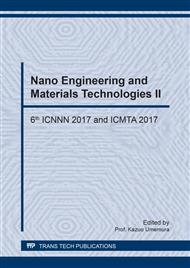[1]
S. Hoseinlaghab, S. S. Mirjavadi, N. Sadeghian, I. Jalili, M Azarbarmas, M. K. Besharati Givi. Influences of welding parameters on the quality and creep properties of friction stir welded polyethylene plates, Materials & Design, 67, 369-378, (2015).
DOI: 10.1016/j.matdes.2014.11.039
Google Scholar
[2]
S.S. Mirjavadi, M. Alipour, S. Emamian, S. Kord, A.M.S. Hamouda, P.G. Koppad, R. Keshavamurthy. Influence of TiO2 nanoparticles incorporation to friction stir welded 5083 aluminum alloy on the microstructure, mechanical properties and wear resistance. Journal of Alloys and Compounds, 712, 795–803, (2017).
DOI: 10.1016/j.jallcom.2017.04.114
Google Scholar
[3]
A Esmaeili, A.M.S. Hamouda. The role of intermetallic compounds and composite-like structure development during dissimilar friction stir welding of aluminum to brass on metallurgical and flexural characteristics. Mechanical and Aerospace Engineering (ICMAE), 2016 7th International Conference on.
DOI: 10.1109/icmae.2016.7549509
Google Scholar
[4]
A. Esmaeili, M.K. Besharati Givi, H.R. Zareie Rajani, Investigation of weld defects in dissimilar friction stir welding of aluminium to brass by radiography. Science and Technology of Welding and Joining. 539-543.
DOI: 10.1179/1362171812y.0000000044
Google Scholar
[5]
S. S. Mirjavadi, S. Rabby, N. Shafiei, B. Mohasel Afshari, M. Kazemi. On size-dependent free vibration and thermal buckling of axially functionally graded nanobeams in thermal environment. Applied Physics A 123(5), 315, (2017).
DOI: 10.1007/s00339-017-0918-1
Google Scholar
[6]
M. Azimi, S.S. Mirjavadi, N. Shafiei, A.M.S. Hamouda. Thermo-mechanical vibration of rotating axially functionally graded nonlocal Timoshenko beam. Applied Physics A 123 (1), 104, (2017).
DOI: 10.1007/s00339-016-0712-5
Google Scholar
[7]
M. Azimi, S. S. Mirjavadi, N. Shafiei, A.M.S. Hamouda, Ehsan Davari. Vibration of Rotating Functionally Graded (FG) Timoshenko Nanobeam with Nonlinear Thermal Distribution. Mechanics of Advanced Materials and Structures, 1-14, (2017).
DOI: 10.1080/15376494.2017.1285455
Google Scholar
[8]
H. Mirahmadi, M. Azimi, M. Azimi, S. S. Mirjavadi. Calculation of stress intensity factor for functionally graded cylinders with two radial cracks using the weight function method. Theoretical and Applied Fracture Mechanics, 85, 447-456, (2016).
DOI: 10.1016/j.tafmec.2016.06.004
Google Scholar
[9]
M. Azimi, S. S. Mirjavadi, S. A. Asli. Investigation of Mesh Sensitivity Influence to Determine Crack Characteristic by Finite Element Methods. Journal of Failure Analysis and Prevention 16 (3), 1-7, (2016).
DOI: 10.1007/s11668-016-0117-y
Google Scholar
[10]
M. Azimi, S. S. Mirjavadi, S. A. Asli , AMS Hamouda. Fracture Analysis of a Special Cracked Lap Shear (CLS) Specimen with Utilization of Virtual Crack Closure Technique (VCCT) by Finite Element Methods. Journal of Failure Analysis and Prevention 17, 304-314, (2017).
DOI: 10.1007/s11668-017-0243-1
Google Scholar
[11]
G. A. Nourollahi, M. Farahani, A. Babakhani, S.S. Mirjavadi. Compressive Deformation Behavior Modeling of AZ31 Magnesium Alloy at Elevated Temperature Considering the Strain Effect, Materials Research 16, no. 6, 1309–1314, (2013).
DOI: 10.1590/s1516-14392013005000149
Google Scholar
[12]
S.S. Mirjavadi, A. Matin, N. Shafiei, S. Rabby, B. Mohasel Afshari. Thermal buckling behavior of two-dimensional imperfect functionally graded micro-size tapered porous beam Journal of Thermal Stresses, 40(10), 1201-1214, (2017).
DOI: 10.1080/01495739.2017.1332962
Google Scholar
[13]
S.S. Mirjavadi, M. Alipour, A.M.S. Hamouda, A. Matin, S. Kord, B. Mohasel Afshari, P. G. Koppad. Effect of multi-pass friction stir processing on the microstructure, mechanical and wear properties of AA5083/ZrO2 composites. Journal of Alloys and Compounds, Volume 726, 1262-1273, (2017).
DOI: 10.1016/j.jallcom.2017.08.084
Google Scholar
[14]
M. Ebrahimi, A. Zarei-Hanzaki, H.R. Abedi, M. Azimi, S.S. Mirjavadi. Correlating the microstructure to mechanical properties and wear behavior of an accumulative back extruded Al-Mg2Si in-situ composite, Tribology International, Volume 115, November 2017, Pages 199-211.
DOI: 10.1016/j.triboint.2017.05.034
Google Scholar


